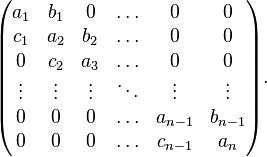Continuant (mathematics)
In algebra, the continuant is a multivariate polynomial representing the determinant of a tridiagonal matrix and having applications in generalized continued fractions.
Definition
The n-th continuant, K(n), of a sequence a = a1,...,an,... is defined recursively by
It may also be obtained by taking the sum of all possible products of a1,...,an in which any pairs of consecutive terms are deleted.
An extended definition takes the continuant with respect to three sequences a, b and c, so that K(n) is a polynomial of a1,...,an, b1,...,bn−1 and c1,...,cn−1. In this case the recurrence relation becomes
Since br and cr enter into K only as a product brcr there is no loss of generality in assuming that the br are all equal to 1.
Applications
The simple continuant gives the value of a continued fraction of the form ![[a_0;a_1,a_2,\ldots]](../I/m/7c680f6e729c8d6aae13541e5b016208.png) . The n-th convergent is
. The n-th convergent is
The extended continuant is precisely the determinant of the tridiagonal matrix
In Muir's book the "extended" continuant is simply called continuant.
References
- Thomas Muir (1960). A treatise on the theory of determinants. Dover Publications. pp. 516–525.
- Cusick, Thomas W.; Flahive, Mary E. (1989). The Markoff and Lagrange Spectra. Mathematical Surveys and Monographs 30. Providence, RI: American Mathematical Society. p. 89. ISBN 0-8218-1531-8. Zbl 0685.10023.
- George Chrystal (1999). Algebra, an Elementary Text-book for the Higher Classes of Secondary Schools and for Colleges: Pt. 1. American Mathematical Society. p. 500. ISBN 0-8218-1649-7.





